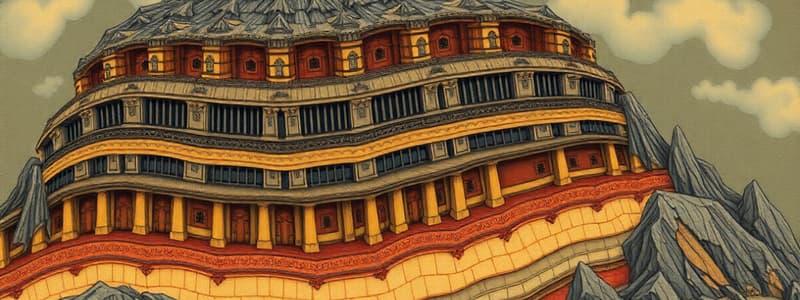Podcast
Questions and Answers
Which of the following is NOT a type of convergent boundary?
Which of the following is NOT a type of convergent boundary?
- Oceanic to oceanic
- Oceanic to continental
- Continental to continental
- Transform boundaries (correct)
What is the relationship between silica content and magma viscosity?
What is the relationship between silica content and magma viscosity?
- More silica results in more viscous magma. (correct)
- All magma is equally viscous regardless of silica content.
- More silica results in less viscous magma.
- Silica content has no effect on magma viscosity.
Which of the following best describes the asthenosphere?
Which of the following best describes the asthenosphere?
- The uppermost layer of the Earth's crust.
- The innermost layer of the Earth.
- The rigid outer part of the Earth.
- The elastic, plastic-like part of the mantle. (correct)
What type of fault occurs when rock is forced upward?
What type of fault occurs when rock is forced upward?
What is the purpose of sonar in oceanic studies?
What is the purpose of sonar in oceanic studies?
What characteristic distinguishes love waves from rayleigh waves?
What characteristic distinguishes love waves from rayleigh waves?
Which of the following statements about primary waves is true?
Which of the following statements about primary waves is true?
At approximately what depth does the velocity of seismic waves change according to Andrija Mohorovicic?
At approximately what depth does the velocity of seismic waves change according to Andrija Mohorovicic?
Which layer of the Earth is the thinnest and made up of less dense rocks such as granite?
Which layer of the Earth is the thinnest and made up of less dense rocks such as granite?
What is a shadow zone in relation to seismic waves?
What is a shadow zone in relation to seismic waves?
Study Notes
Ring of Fire
- Approximately 90% of all earthquakes occur along the Pacific Ring of Fire.
- Countries located within this zone include South America, Southeast Asia, America's Northwest, New Zealand, Alaska, Russia, and Japan.
Volcanic Activity
- Higher silica content increases magma viscosity.
- 75% of all volcanoes in the U.S. are found in Alaska.
- Blocky lava is indicative of thick, viscous magma that traps gases.
- Hornblende crystals form magma at great depths in the Earth.
Earth's Layers
- The lithosphere is the rigid outer layer, composed of the crust and upper mantle.
- The asthenosphere lies below the lithosphere and has a plastic-like quality.
Faults and Plate Boundaries
- A fault is a fracture zone between two rock blocks.
- Reverse faults occur when rock is pushed upward, causing the hanging wall to move up.
- A subduction zone allows oceanic crust to sink beneath a trench into the mantle at convergent boundaries.
- Strike-slip faults are vertical fractures where rocks move horizontally.
Mapping and Technology
- SONAR (Sound Navigation and Ranging) is used to map the ocean floor.
- GPS (Global Positioning System) aids in location tracking.
- Philvolcs stands for the Philippine Institute of Volcanology and Seismology.
Mid-Ocean Ridges
- The Mid-Atlantic Ridge is the longest oceanic range in the Atlantic Ocean.
- Mid-ocean ridges form a system of underwater mountains due to divergent plate movements.
Types of Plate Boundaries
- Three primary boundaries:
- Convergent (compression)
- Transform (shearing)
- Divergent (caloric expansion and rifting).
Types of Convergent Boundaries
- Oceanic to continental
- Oceanic to oceanic
- Continental to continental
Seismic Waves
- Seismic waves are generated by sudden movements within the Earth, such as slipping along a fault.
- Earthquakes are vibrations caused by these seismic waves, classified into two main types: body waves and surface waves.
Surface Waves
- Love waves are faster, move horizontally side-to-side, and cause significant structural damage.
- Rayleigh waves roll along the ground, causing up-and-down and side-to-side movements, responsible for most felt shaking.
Body Waves
- Primary waves (P-waves) can travel through liquids, solids, and gases and are identified as compressional waves.
- Secondary waves (S-waves) are slower, can only travel through solids, and create a side-to-side swaying motion.
Earth's Internal Layers
- The depths of the Earth include:
- Inner Core
- Outer Core
- Mantle
- Crust
Earth's Crust Composition
- The crust, the thinnest layer, is categorized into continental and oceanic regions.
- Continental crust has a thickness of 35-40 km and consists of less dense rocks like granite.
- Oceanic crust, being denser, is thinner at around 7-10 km and composed of rocks like basalt.
- The most abundant element in the crust is oxygen, while hydrogen is the least prevalent.
Studying That Suits You
Use AI to generate personalized quizzes and flashcards to suit your learning preferences.
Description
Test your knowledge on the dynamic components of Earth's structure, including the Pacific Ring of Fire, volcanic activity, and different types of geological faults. This quiz covers essential concepts related to Earth's layers, magma properties, and plate boundaries.




